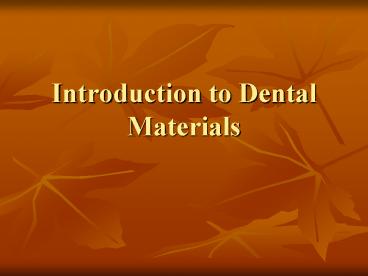Introduction to Dental Materials - PowerPoint PPT Presentation
1 / 23
Title:
Introduction to Dental Materials
Description:
Introduction to Dental Materials Three basic classes of materials: Metals Polymers Ceramics Metals At the atomic level , the atoms are bonded together by metallic bond. – PowerPoint PPT presentation
Number of Views:312
Avg rating:3.0/5.0
Title: Introduction to Dental Materials
1
Introduction to Dental Materials
2
(No Transcript)
3
- Three basic classes of materials
- Metals
- Polymers
- Ceramics
4
Metals
- At the atomic level , the atoms are bonded
together by metallic bond. - -metallic luster.
- -excellent electrical and thermal conductivity.
- -ability to be shaped (malleability).
- -strength, hardness, and high density.
- -Opaque
5
Metals
- What is alloy?
- Mixture of 2 or more metals
- What is metal??
- Metals versus alloys in dentistry.
6
- Types of metals in dentistry
- Noble (gold, pt, Pd, ..
- Semi-noble ( old term).gold is replaced with
silver - Non-noble.
7
Metals
- Preformed metals
- Cohesive gold
- Amalgam
- Wrought wires
8
(No Transcript)
9
Metals
- Casting metals
- The restoration is fabricated outside the mouth
utilizing the lost wax technique.
10
(No Transcript)
11
POLYMERS
- They are widely used in dentistry.
- Polymers versus plastics???
- Plastic is any material cabable to be shaped .
- Ductile metals considered as plastic
12
- Polymers
- this term means many parts
- Polymerisation process by which the monomer is
converted into polymer.
13
Polymers
- They are bonded by covalent bonding along the
backbone, and ionic bonding . - Polymers are prepared in form of dough then
shaped into desired shapes. - They harden by
- -physical reaction,(cooling, or evapration).
Waxes, - -chemical reaction,
14
- Types
- Impression.
- Waxes.
- Denture bases.
- TCRM.
15
(No Transcript)
16
(No Transcript)
17
(No Transcript)
18
Ceramics
- They are made of metallic oxides.
- Porcelain. Produced by sintering
- Glass, produced by melting and fusion of the
oxides.
19
ceramics
- They are bonded by ionic bonds.
- No free electron to conduct heat or electricity.
- Poor thermal conductor
- Stable ,biocompatible
- Trasparent.????
- Traslucency, due to air bubles
- Three dimensional crystal structure.
- Brittle
20
- Types of ceramics
- Porcelain
- Gypsum
- Investment
- Cements
21
(No Transcript)
22
(No Transcript)
23
(No Transcript)





















![[PDF] Introduction to Dental Materials Free PowerPoint PPT Presentation](https://s3.amazonaws.com/images.powershow.com/10080770.th0.jpg?_=202407180210)









